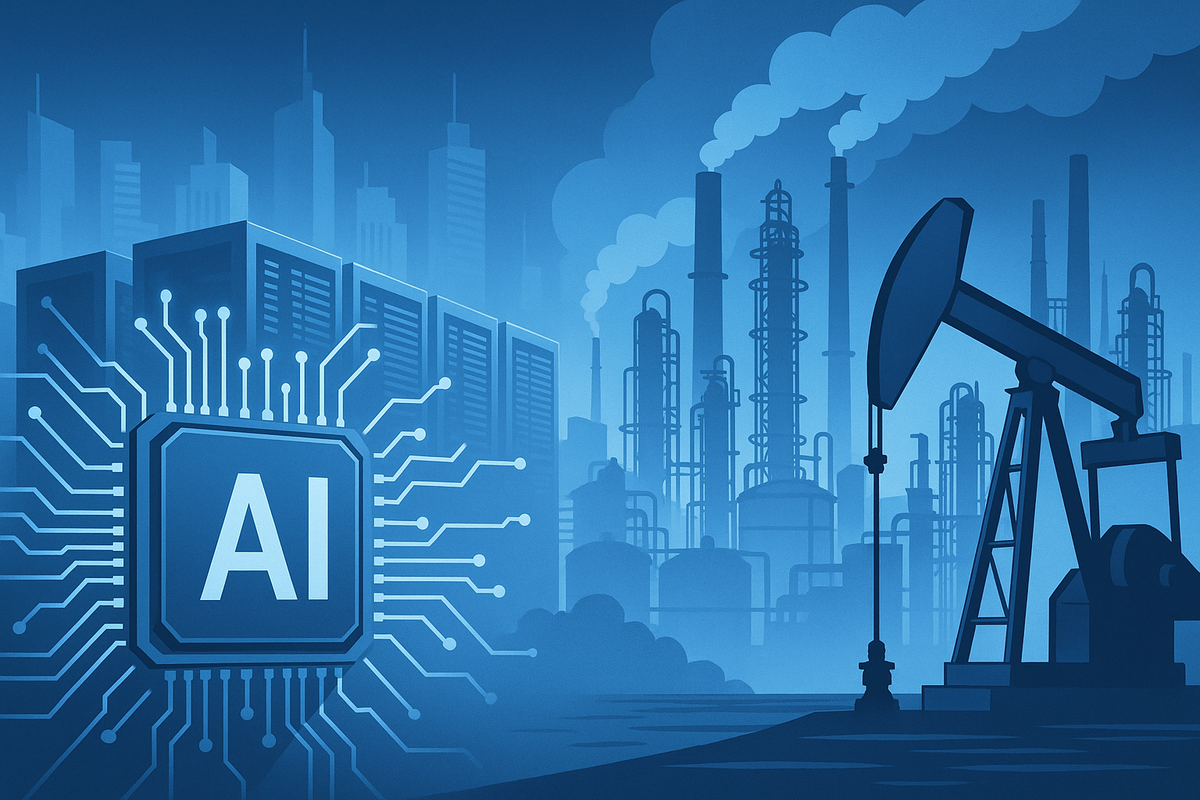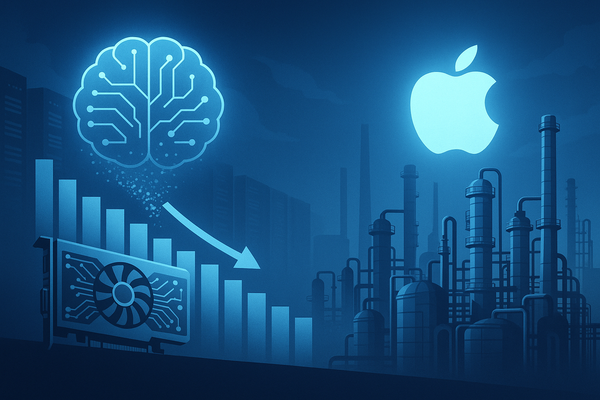Nvidia and the Hyperscalers Multiples have Peaked: How the AI Data Center Boom Mirrors the 1980s Petrochemical Overbuild

In industrial history, overcapacity always begins with optimism. The late 1970s petrochemical buildout was justified by the same logic now driving the global AI infrastructure race: seemingly infinite demand, technological inevitability, and geopolitical diversification. Western chemical giants, Dow, Union Carbide, ICI, believed that supplying technology to Saudi Arabia would expand global market share. Instead, it built their replacement.
The Saudi model was elegant and ruthless. Flaring natural gas from oil extraction was turned into feedstock for methanol, polyethylene, and ammonia. Low-cost energy translated directly into exportable intermediates. By 1985, Saudi Arabia produced so much basic chemical product that it crashed the very markets it sought to serve. Union Carbide’s market capitalization fell by two-thirds, Dow and ICI restructured entire divisions, and the West’s dominance of commodity chemicals ended. The lesson was clear: when capital, energy, and ambition combine faster than end demand, margins collapse.
The Modern Buildout: Energy to Compute
The same equation is now being re-run with a new input, electricity instead of ethane. Through its sovereign wealth fund, Saudi Arabia is constructing 7,600 megawatts of AI and cloud data center capacity—twenty-five times its current base, and almost one-third of all U.S. data center power. Across the Gulf, total regional capacity exceeds 12,000 megawatts planned or underway by 2035, equivalent to nearly half of 2023’s global installed base.
These projects are underpinned by partnerships with every major Western technology firm. Nvidia, AMD, and Intel are supplying tens of thousands of GPUs. Amazon, Microsoft, Oracle, and Google are providing architecture, cloud integration, and capital. The Kingdom is again playing its traditional role: using low-cost energy to absorb global technology and convert it into an export industry. Data, not oil, will be the new flow of value.
The mismatch, however, is profound. The entire GCC, 60 million people producing 3.5% of world GDP, cannot consume 12% of global data capacity. Even assuming rapid regional digitalization and peace-driven growth, projected domestic demand by 2035 supports only 5,000 megawatts. The remaining 7,000 megawatts, or nearly 60% of output, must be exported.
Export-Led Capacity: The Old Trap
The petrochemical precedent is precise. Saudi Arabia’s 1980s expansion was built on the same premise, export-oriented capacity serving Western markets. SABIC produced up to 90% of output for export, leveraging energy subsidies and joint ventures with Dow, Shell, and Carbide. When Western markets themselves became oversupplied, export channels shut overnight. Capacity utilization fell below 60%, and the entire industry entered a decade-long earnings drought.
The new AI export model risks repeating this dynamic. Data centers are not consumer products; they are infrastructure intermediates. Their value depends on end-user applications—AI services, model training, and enterprise software adoption. When all major economies are simultaneously building capacity to serve the same future demand, the global system produces structural overbuild. The Middle East, like 1980s Saudi petrochemicals, becomes a marginal supplier, vulnerable to small demand shocks and margin compression from cost competition.
The Peace Dividend and Its Limits
The optimistic scenario, the “peace dividend,” suggests that geopolitical normalization could absorb part of this overcapacity. Modeling shows that even with strong peace outcomes, the math remains unfavorable. Under modest peace (50% probability), Israel-Palestine normalization, Iranian reintegration, and higher tourism and FDI growth lift demand 30–40%, yet still leave roughly 5,000 megawatts of excess capacity, or 42% oversupply.
A major peace scenario (30% probability), encompassing full regional normalization and Western corporate relocation, reduces excess to around 17%, manageable but still distortionary. Only under a transformational outcome, where the region becomes a global AI hub rivaling the U.S. and China, does overcapacity disappear. The probability of that outcome is estimated near 15%. Weighted across scenarios, the expected overcapacity remains roughly 26%, a level sufficient to depress utilization and margins for years.
China’s Counterweight
Even a best-case peace outcome cannot offset the second source of structural imbalance: China’s rise as a vertically integrated AI ecosystem. With 50% power subsidies for data centers using domestic chips and evidence of 90% cost reductions in model training from innovations like DeepSeek, China has internalized its entire AI supply chain. The result is an ecosystem where demand and production are matched by policy design. The West, by contrast, is globalizing its supply base and decentralizing demand, duplicating investment without coordination.
In 1980, the parallel was Japan: efficient, integrated, and export-led, crushing margins for Western chemical producers. Today it is China, doing to AI infrastructure what Japan once did to ethylene.
From Commodities to Intelligence
In the petrochemical era, survival required evolution. By the late 1980s, the most successful chemical firms had abandoned bulk production for high-margin specialties—coatings, pharmaceuticals, catalysts, and composites. ICI, once the largest chemical company in the world, transformed into a portfolio of advanced materials and life sciences. Dow and DuPont followed the same trajectory.
The same shift is emerging in artificial intelligence. As infrastructure becomes commoditized, value migrates upward. Agentic AI systems, autonomous platforms capable of reasoning, decision-making, and task orchestration, will become the “specialty chemicals” of the AI economy. They require far less capital, enjoy software-like margins, and will be the principal beneficiaries of falling compute costs.
Market Implications
The structural timeline aligns almost perfectly with the 1978–1983 inflection of the petrochemical cycle. In that period, Union Carbide, Dow, and ICI peaked in valuation just as Saudi capacity came online. Their collapse began 18–24 months later. Nvidia, AMD, and ASML appear to be in the same phase: valuations peaked in late 2025, exactly as record capacity expansion across the U.S., Europe, and the Gulf accelerates.
Expected equity outcomes mirror the 1980s sequence: infrastructure producers and capital-intensive hardware firms decline 40–50%, cloud operators face 30–40% margin compression, and asset-light application providers outperform. The rotation from hardware to intelligence parallels the shift from commodity chemicals to specialty products four decades ago.
Structural Consequences
The broader consequence is macroeconomic. The simultaneous construction of global AI capacity represents the largest capital misallocation since the shale boom. Excess capacity will suppress pricing power, flatten technological differentiation, and transfer value from infrastructure to application layers. For investors, this is both a risk and an opportunity, the end of one supercycle and the quiet birth of another.
The Paradox of Progress
In the 1980s, Western firms built the Saudi petrochemical empire that ultimately replaced them. Today, they are constructing the Middle East’s AI infrastructure, once again mistaking global reach for sustainable profit. The mechanism of overcapacity is timeless: technology outpaces end demand, capital chases efficiency, and the cycle collapses under its own weight.
But as before, innovation migrates. Out of the wreckage of overbuilt infrastructure will emerge the next layer of value: agentic intelligence, adaptive systems, and the software of cognition itself. History will rhyme once more, but its direction will remain the same, away from commodities and toward capability.
In the next writeup, we will identify the winners and losers of this transition—the companies positioned to lead the post-infrastructure phase of the AI economy.





